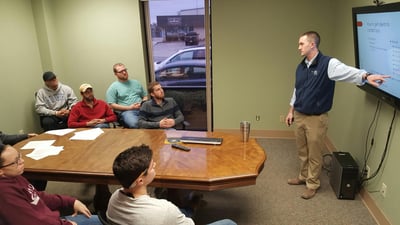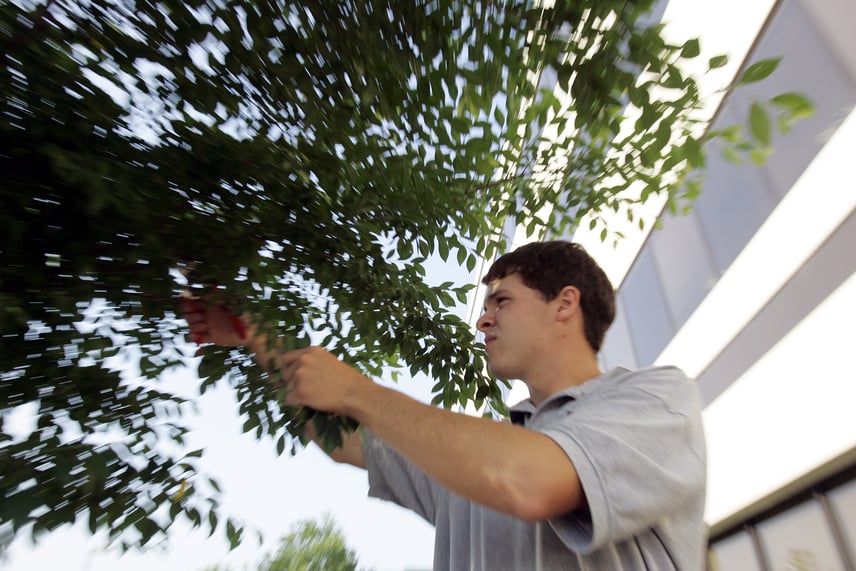When it comes to our landscapes, we tend to focus more on the beauty and appearance of our properties and neglect the fact that our landscapes are dynamic ecosystems. There are thousands of different types of critters big and small living in our landscapes. Some are beneficial, some are pests, but most are benign. Just because a pest or disease is present, doesn't mean it will become a problem. It takes a trained professional to know which potential problem requires action.
Trained horticulturists can identify potential problems long before any serious damage occurs. Through routine landscape scouting and understanding the landscape’s ecosystems, trained professionals can discern which potential problems require immediate attention and recommend treatment solutions. Or, they might determine that a problem will be cleared up through natural processes, so no treatment is required.
At Klausing Group, we take an IPM approach to preventing and managing pest problems in the landscape. It is part of how we design and manage landscapes to do more. IPM stands for Integrated Pest Management, and it is an ecosystem-based strategy that focuses on cultural practices, using pest and disease resistant plants, releasing beneficial insects, and implementing smart design solutions to maximize ecosystem services. If chemicals are required, we begin with biorational products and other products that are highly selective or specialized to a specific pest or disease. Products that kill indiscriminately are avoided.
 While traditional pest control is chemical intensive, IPM is knowledge intensive.
While traditional pest control is chemical intensive, IPM is knowledge intensive.
Knowledge is one of Klausing Group's values, and we invest in continual education for our account managers by: 1) training on effective landscape scouting; 2) reviewing university publications on pests and diseases; and 3) attending seminars to receive education required for maintaining certifications.
The reality is, pests are a natural and necessary part of healthy landscape ecosystems. Pests are food for beneficial insects and birds. The goal is not eradication, but rather to ask more of your landscape and create a stable ecosystem in which pests cannot develop into pest problems.
Unfortunately, we are oftentimes limited in our ability to fully implement IPM strategies in urban environments. The wrong types of plants are used. Plants are installed in the wrong places. Monocultures of boxwoods and burning bushes create their own issues, and invasive species act outside the normal restraints of ecosystems. Because of these issues, commercial property landscapes in Central Kentucky face the same predictable pests year after year.
Recurring Pests in Central Kentucky

There are two types of recurring pests: the kind you find everywhere, and pests that are sporadic. The ubiquitous, recurring pest attacks every single member of a species of plant year after year. They’re a regularly occurring part of our natural environment here in Central Kentucky. One example is boxwood psyllids. Every boxwood in Central Kentucky is attacked every year by these psyllids.
On the other hand, a sporadic recurring pest is one that shows up every year, but it does not attack every single plant. An example is bagworms. Each year they infest many, but not all, arborvitae.
Basically, there are certain pests you can absolutely expect (psyllids) and others that are sometimes a problem, but not always (bagworms).
How do we deal with recurring pests?
First, we recommend including treatment for the usual suspects in landscape maintenance contracts because they are problems every year. The old saying about an ounce of prevention being worth a pound of cure is true with managing pests.
Here is a list of plants to include in your annual treatment plan for preventing damage from ubiquitous recurring pests.
- Apple Scab: Apple scab is a disease that is common to rosaceous plants in Central Kentucky, including crab apple trees and hawthorns.
- Boxwood Diseases: Boxwoods in this region are susceptible to boxwood psyllids, boxwood leaf miners and boxwood mites. We preventively treat for all three of these issues.
- Emerald Ash Borer: In this part of the country, Ash trees are prime targets for the notorious Emerald Ash Borer. A treatment cycle is necessary to protect these beautiful trees.
- Japanese Beetles: Rather than waiting for the demise of your rose bushes, we recommend preventive treatment.
Getting to the Root of Pest Problems
Your landscape is a major investment, and routine landscape scouting protects your investment – but only if the landscape professional scouting your property understands what they are seeing. It takes training and experience to expertly identify and solve plant health problems. The account manager must dig deep and ask, “Why is this problem occurring? Is it a symptom of a deeper issue?”

An example of a common problem in Central Kentucky is a black sooty mold growing on the surface of leaves on purple leafed redbuds. This is a symptom that most people can notice. An experienced gardener will know the black sooty mold is a symptom of scale insects feeding on the branches. The black sooty mold grows on the honeydew excreted by insects and is ugly but harmless to the plant other than reducing photosynthesis. But it takes a trained professional to know that purple leafed redbuds are highly susceptible to root rots, or to notice the slight signs of root rot manifest in the crown of the tree.
Just as people are more likely to catch a cold when stressed or tired, distressed trees are more likely to suffer from pest problems. And it takes an expert to understand how to change the cultural conditions causing the root rot to flourish. Treating any of the symptoms without treating the real cause of all the problems (the growing conditions of the tree) is wasted money and the tree will have a short life.
Identifying and solving problems with growing conditions early on could prevent all these issues from occurring in the first place. Does your landscape receive routine landscape scouting? Is your account manager an expert offering comprehensive solutions? Or, are you paying to treat symptoms?
A Proactive Pest Management Approach
By taking a proactive IPM approach to managing pests in the landscape, we address true pest problems and protect plant health—and we avoid using treatments that can harm beneficial insects, or do more harm than good. IPM involves taking a holistic approach, beginning with plant selection and choosing varieties that attract beneficial insects that will prevent harmful pests. (For example, beneficial insects can parasitize white grubs.)
When we ask more of our landscapes and care for them properly, we can create a healthy ecosystem that works with nature and we can avoid using treatments that work against it.
Let’s talk more about how you can take a proactive approach to managing pests on your commercial property, and what to expect this spring and summer so you can prepare now and protect plants. Call us any time in Lexington at 859.254.0762, or in Louisville at 502.264.0127. Or, fill out this simple contact form and we’ll get in touch with you.


